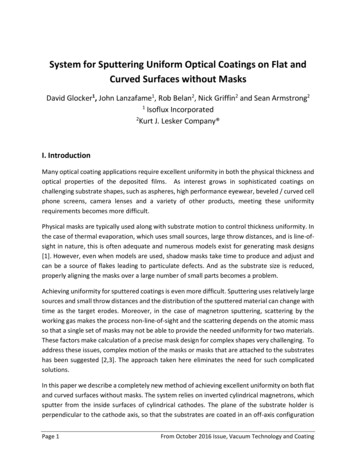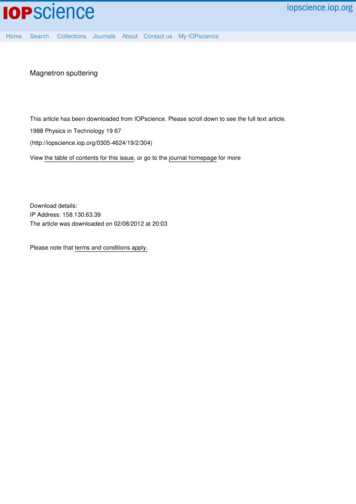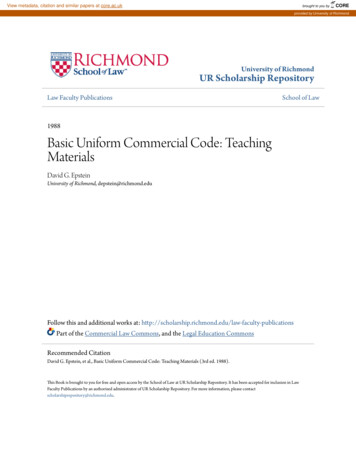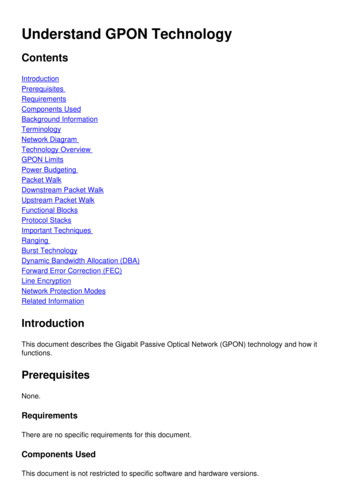
Transcription
System for Sputtering Uniform Optical Coatings on Flat andCurved Surfaces without MasksDavid Glocker1, John Lanzafame1, Rob Belan2, Nick Griffin2 and Sean Armstrong21Isoflux Incorporated2Kurt J. Lesker Company I. IntroductionMany optical coating applications require excellent uniformity in both the physical thickness andoptical properties of the deposited films. As interest grows in sophisticated coatings onchallenging substrate shapes, such as aspheres, high performance eyewear, beveled / curved cellphone screens, camera lenses and a variety of other products, meeting these uniformityrequirements becomes more difficult.Physical masks are typically used along with substrate motion to control thickness uniformity. Inthe case of thermal evaporation, which uses small sources, large throw distances, and is line-ofsight in nature, this is often adequate and numerous models exist for generating mask designs[1]. However, even when models are used, shadow masks take time to produce and adjust andcan be a source of flakes leading to particulate defects. And as the substrate size is reduced,properly aligning the masks over a large number of small parts becomes a problem.Achieving uniformity for sputtered coatings is even more difficult. Sputtering uses relatively largesources and small throw distances and the distribution of the sputtered material can change withtime as the target erodes. Moreover, in the case of magnetron sputtering, scattering by theworking gas makes the process non-line-of-sight and the scattering depends on the atomic massso that a single set of masks may not be able to provide the needed uniformity for two materials.These factors make calculation of a precise mask design for complex shapes very challenging. Toaddress these issues, complex motion of the masks or masks that are attached to the substrateshas been suggested [2,3]. The approach taken here eliminates the need for such complicatedsolutions.In this paper we describe a completely new method of achieving excellent uniformity on both flatand curved surfaces without masks. The system relies on inverted cylindrical magnetrons, whichsputter from the inside surfaces of cylindrical cathodes. The plane of the substrate holder isperpendicular to the cathode axis, so that the substrates are coated in an off-axis configurationPage 1From October 2016 Issue, Vacuum Technology and Coating
(not directly facing the targets). By adjusting the position of the substrates along the cathodeaxis and rotating them in a conventional dual planetary motion, excellent uniformity is possibleon substrates ranging in shape from flat to cylindrical.II. System Descriptiona. Cathodes and Cathode OperationThe key to the system is the use of two inverted cylindrical magnetron (ICM) cathodes. Eachcathode has two electrodes that are driven with mid-frequency AC power, as shown in Figure 1.Figure 1. Cutaway view of a cathode showing the unbalanced magnetic field and off-axissubstrate configurationsMetal targets with inside diameters of 400 mm and heights of 100 mm fit into each electrodeand for the work reported here, one cathode contained two Si targets and the other cathodecontained two high index material targets, either Ti or Ta. Sputtering was done with the targetsurfaces completely oxidized (the fully poisoned mode) in order to work in a stable part of thehysteresis curve. The process gases were introduced above both cathodes and typical conditionswere 35 sccm of both Ar and O2, which resulted in a pressure of 3 mTorr as measured bycapacitance manometers in each cathode. The SiO2 was deposited at a total power of 2.0 kW,the TiO2 at 4.0 kW and the Ta2O5 at either 4.0 kW or 6.0 kW. At 2.0 kW the SiO2 deposition rateis 12 nm/min and at 6.0 kW the Ta2O5 rate is 11 nm/min.Figure 1 shows two alternative substrate locations, referred to as the z position. When thesubstrate holders are on the transfer arm in the central chamber their z position is zero and a zposition of 30 cm places them at the bottom of the lower target in each cathode. Thicknessuniformity on substrates with different curvatures is controlled by simply adjusting the z positionof the substrate holder.Page 2From October 2016 Issue, Vacuum Technology and Coating
b. Ion Assisted Deposition without an Ion SourceThe ICM cathodes incorporate unbalanced magnetic fields, as illustrated by the arrows in Figure1 [4,5]. A very important consequence of this magnetic field configuration in combination withmid-frequency power is that significant ion production occurs when secondary electrons crossthe field lines as they flow to the instantaneous anode [6]. In addition, secondary electrons canmove easily along the unbalanced field lines, represented by the large arrows extending out theends of the cathode, and they produce a significant negative self-bias on the substrate. The selfbias and high ion density result in a low energy ion flux of approximately 2 mA/cm2 that bombardsthe growing film [5]. This is similar to the ion fluxes found in other ion enhanced depositionsystems, but without the need for a separate ion source.c. Mechanical ConfigurationFigure 2 is an illustration of the mechanical configuration of the system. The chamber on theupper left is a load lock and a cutaway of one of the cathodes can be seen on the upper right. Thesecond cathode is in the rear.Substrates are held on 300 mm diameter platens and Figure 3 illustrates three arrangements fordifferent size substrates that were used in this work. BK7 lenses and Si wafers with diameters upto 50.8 mm were coated using dual axis rotation in a configuration that accommodates up to 16substrates per platen. Alternatively, four substrates with diameters up to 127 mm can be coatedper platen using single axis rotation. Finally, to determine the uniformity on large stationarysubstrates, individual 152 mm diameter Si wafers were placed as shown in Figure 3 and thethicknesses were measured as functions of the radial position for static substrates coated atseveral z positions.The load lock is used to increase throughput and improve coating repeatability. A platen ismanually loaded into the load lock and once the setpoint pressure is reached it automaticallymoves from the load lock onto a transfer arm in the large central chamber. The platen is thenrotated to a position below the appropriate cathode and lifted into position in that cathode. Fullcomputer control tracks the platen and takes it through the deposition cycle following a definedprogram recipe.Page 3From October 2016 Issue, Vacuum Technology and Coating
Figure 2. Cutaway view of the system layout showing the load lock on the left and sputteringcathode on the right.Figure 3. Illustrations showing the dual axis rotation used for 50.8 mm diameter substrates,single axis rotation used for 100 mm substrates, and the configuration used for radialthickness measurements on static substratesPage 4From October 2016 Issue, Vacuum Technology and Coating
The system is pumped by a 2,000 l/s turbomolecular pump in the central chamber and theprocess gases are introduced above the cathodes, as described earlier. The platens are designedso that they limit the conductance between the cathodes and the central chamber, so that duringoperation the central chamber is at less than 1 mTorr pressure. This allows the pressure in eachcathode to be independently varied between 1 and 5 mTorr while both are operating.Platens can be in process in both cathodes simultaneously and while a platen is being pumpeddown or vented in the load lock. This offers remarkable flexibility in how the system can beoperated. Since the uniformity for a given substrate curvature depends on where the platen ispositioned within the cathode, substrates of different curvatures can be in processsimultaneously. Moreover, platens receiving different coating structures can be in processsimultaneously as well. A platen of substrates requiring a 16 layer structure and a platen requiringa 200 layer structure can be coating together and when the 16 layer structure is complete it canbe removed from the system while the 200 layer structure continues. Accommodations for anoptical monitoring system capable of either reflection, transmission or both are built into thesystem.There are several additional advantages to the cathode design and off-axis configuration.Because the substrates do not face the targets directly, they are not bombarded by high energyreflected neutral atoms and negative oxygen ions formed at the target surface, which are knownto produce high levels of stress in sputtered coatings. Moreover, the total target area in eachcathode is 2,500 cm2 so that cylindrical targets that are only 2 mm thick provide the samematerial inventory as a 25 cm diameter by 1 cm thick conventional circular magnetron. The muchshallower erosion grooves that result with thin targets have a minimal effect on the sputteredmaterial distribution over the target lifetime. Finally, the large target area permits operation atpower densities of 3 W/cm2 or less, which virtually eliminates arcs and microarcs that are sourcesof particulates that can get entrained in the coatings.III. Experimental Procedures and Resultsa. Refractive IndicesThe reflectance spectra of coatings deposited on 50.8 mm diameter Si wafers were measuredusing a Filmetrics Model F2 and the values for the indices and thicknesses were found by usingthe Filmetrics internal software to generate the best fit to the data in each case. The fits for theSiO2 and Ta2O5 measurements were 99.9% for three samples of each material made in separateruns. Previously, indices for SiO2 and Ta2O5 were measured using ellipsometry on coatingsproduced in a prototype system having targets with inside diameters of 330 mm, but that wereotherwise identical to the ones in the present system [5]. Table 1 shows the results for the realpart of the index at a wavelength of 633 nm for both sets of measurements.Page 5From October 2016 Issue, Vacuum Technology and Coating
MaterialPresent SystemPrototype SystemSiO21.459 .0041.47Ta2O52.147 .0162.14Table 1. Refractive indices for films made in the present system measured using reflectancespectroscopy and for films made in a prototype system that were measured usingellipsometry.The data in Table 1 show that the coatings produced with unbalanced inverted cylindricalmagnetron cathodes using mid-frequency power have indices that are comparable to thoseproduced in other ion enhanced deposition processes.Ta2O5 samples coated on BK7 glass were submitted for durability testing according to MIL-C675C, MIL-C-48497A and MIL-M-13508C and met the requirements for adhesion, humiditystability, temperature stability and moderate abrasion. SiO2 and Ta2O5 samples deposited in theprototype system were measured for their change in thickness and index as functions oftemperature up to 350 C using ellipsometry [5]. No changes in either the thicknesses or indiceswere seen up to 150 C. At 350 C the indices of both materials increased by approximately 0.4%and the thicknesses of both decreased by approximately 0.4%, leaving the optical thicknessunchanged in both cases.b. SiO2 StressThe stress of SiO2 deposited in the system was measured in two separate experiments. In thefirst, a 965 nm thick coating was deposited onto a 25 mm diameter by 250 micron thick BK7 glassdisc and the change in curvature was measured optically. In the second a 957 nm thick coatingwas deposited onto a 50.8 mm diameter by 500 micron thick 100 oriented Si wafer and thechange in curvature was measured using a stylus profilometer. In both cases Stoney’s equationwas used to calculate the stress and yielded compressive values of -230 MPa and -200 MPa,respectively.c. Thickness UniformityAs discussed, film thickness uniformity on substrates with different curvatures is controlled byadjusting their z position along the axis of a cathode during deposition. In order to map thethickness uniformity on substrates with various curvatures, TiO2 was deposited onto 50.8 mmdiameter BK7 flats and lenses at different z positions. The radii of curvature of the lenses were 51.5, 51.5 mm, 103 mm and 206 mm, where – refers to concave and to convex. Dualplanetary rotation was used in all of these cases. Si wafers with diameters of 127 mm were alsocoated and were only rotated about their own axes, as described earlier and shown in Figure 3.Finally, 152 mm diameter Si wafers were used to measure the thicknesses from the center of thesubstrate holder to a radius of 125 mm at several z positions without any substrate rotation.Page 6From October 2016 Issue, Vacuum Technology and Coating
The reflectance spectra of the coatings on the BK7 substrates were measured at the center andedge using a Filmetrics F10 AR unit with a fiber optic probe. The relative thickness differencefrom the center to the edge for each substrate was calculated by measuring the difference in thewavenumbers at which the reflectance extrema occurred divided by the average wavenumber.Using this method, three replicate sets of measurements of a lens having a radius of curvature of-50.8 mm gave a pooled standard deviation for the total variation of a given measurement of thethickness of 0.05%. The thicknesses on the Si wafers were measured using a Filmetrics Model F2unit.Center Thickness - Edge Thickness (%)Figure 4 shows the difference in thickness from center to edge as a function of z position for TiO2coatings on BK7 lenses having a radius of curvature of 51.5 mm.20-2-4-6-8-10242628303234Z Position (cm)Figure 4. Relative difference in TiO2 film thickness from the center to the edge of convexlenses coated at different z positions. In each case the substrate diameter was 50.8 mm andthe radius of curvature was 51.5 mm.These data illustrate the general result that as a convex substrate is moved further into thecathode, the relative thickness on the edge increases. This agrees well with calculated resultsbased on a model that assume a cosine distribution of material from the targets.Table 2 summarizes the optimum uniformity results for the BK7 flats and lenses as well as for theSi wafers.Page 7From October 2016 Issue, Vacuum Technology and Coating
DiameterRadius ofUniformityCurvature50.8 mmFlat 0.1%50.8 mm 200 mm 0.15%50.8 mm 100 mm 0.15%50.8 mm 50 mm 0.3%50.8 mm-50 mm 0.5%100 mmFlat 0.3%Table 2. Coating thickness uniformity for substrates with a variety of curvatures at theoptimum z position in each caseWe should emphasize that because we are taking advantage of the material distributionproduced by the targets, coatings can be produced on small lenses with uniformities that wouldbe very difficult to achieve using masks because of the registry problem mentioned earlier.Figure 5 shows the relative thickness from the center of the substrate platen out to a radius of125 mm for Ta2O5 deposited onto a stationary substrate.Relative ius (mm)Figure 5. Relative thickness measured from the center of the substrate platen for a stationarysubstrateThese data show that a thickness uniformity of 1.0% can be achieved over 200 mm diameterstationary substrates or 1.5% over 250 mm diameter stationary substrates. And in someapplications it may be desirable to take advantage of the 0.5% uniformity that can be achievedover a 20 mm to 100 mm annulus, which is an area of 300 cm2.Page 8From October 2016 Issue, Vacuum Technology and Coating
IV. SummaryWe have presented results on a new method of depositing coatings onto both flat and curvedsurfaces with excellent uniformity without the need for masks using sputtering sources thatachieve ion enhanced coating quality without a separate ion source. The system is simple andextremely flexible, allowing substrates of different shapes with different layer structures to be inprocess simultaneously. In the case of flat substrates, excellent uniformity is possible over largeareas without motion.For answers to questions or to request further information, please contact Sean Armstrong atseana@lesker.com.V. References1. C. Liu, M. Kong, C. Guo, W. Gao and B. Li, Theoretical design of shadowing masks for uniformcoatings on spherical substrates in planetary rotation systems, Opt. Express, Vol. 20 No. 21,23790–23797 (2012)2. L. Abel-Tiberini, F. Lemarquis and M. Lequime, Masking mechanisms applied to thin-filmcoatings for the manufacturing of linear variable filters for two-dimensional array detectors,Applied Optics, Vol. 47 No. 30, 5706-5714 (2008)3. K. Lee, M. Mazur, K. Lee and R. Martinson, System and method for transporting and sputtercoating a substrate in a sputter deposition system, U. S. Patent No. 6,406,598, issued June 18,20024. D. A. Glocker and M. M. Romach, Unbalanced plasma generating apparatus having cylindricalsymmetry, U. S. Patent No. 6,497,803, issued December 24, 20025. M. M. Romach, G. Scherer, J. Eichenberger, J. Lanzafame, D. Glocker, M. Jaszcar and B. Rayner,Inverted cylindrical magnetron sputtering of optical coatings, Proceedings of the 57th AnnualTechnical Conference of the Society of Vacuum Coaters, 233-238 (2014)6. D. A. Glocker, M. M. Romach and V. W. Lindberg, Recent developments in inverted cylindricalmagnetron sputtering, Surface and Coatings Technology, Vol. 146-147, 457-462 (2001)Page 9From October 2016 Issue, Vacuum Technology and Coating
II. System Description a. Cathodes and Cathode Operation The key to the system is the use of two inverted cylindrical magnetron (ICM) cathodes. Each cathode has two electrodes that are driven with mid-frequency AC power, as shown in Figure 1. Figure 1. Cutaway view of a cathode showing the unbalanced magnetic field and off-axis substrate .










